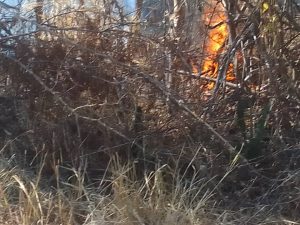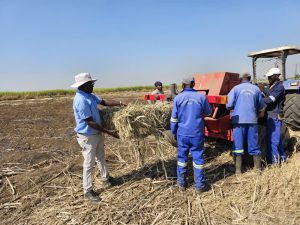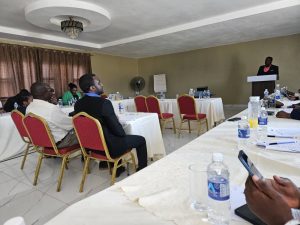Ian Scones
Zimbabwe is presenting itself as the new carbon frontier – the investment destination of choice, with huge areas of forest land to trade on international markets in exchange for carbon credits. But is this wise, will it work, and will it make any difference to the climate?
In September 2023 a $1.5 billion contract for 7.5m hectares of land in Zimbabwe – some 20% of the country’s land area – was signed with a little-known outfit, Blue Carbon, based in Dubai whose founder and chair Sheikh Ahmed Dalmook al-Maktoum is a member of Dubai’s royal family. Similar contracts reputedly are being prepared with Kenya, Tanzania, Angola, Liberia, Rwanda, Papua New Guinea, Bahamas and Dominica, along with maybe 40 other countries in the pipeline.
This came to light just before the global climate summit in Dubai, COP28, and supposedly showed how seriously the petrostate was taking the climate challenge. For others, it raised eyebrows and sparked concern.
The deal is supposed to be ratified under article 6.2 of the Paris climate agreement, whereby countries can make bilateral arrangements to offset carbon emissions under so-called ITMOs (Internationally Transferred Mitigation Outcomes). Avoiding deforestation in another country then can be used to claim credits and to meet targets. Clearly Dubai has quite a lot to offset if it is to meet net zero targets, hence the huge area of land that is included.
Carbon offsetting in the spotlight
Carbon offsetting as a route to climate change mitigation has come under much critique, especially when linked to forest and land use deals. There are so many technical problems – is the baseline realistic, is deforestation really expected, will the trees that are not cut down actually sequester the amount of carbon expected….? And so on.
Studies of forest-based offset schemes have shown again and again that they do not deliver as expected. Indeed, a major investigation showed that over 90% of verified carbon projects were not achieving climate change mitigation claims as claimed. And this was through a previously well-respected verification agency, Verra, whose credibility was dashed (although they offered a riposte). There are unfortunately many, many more agencies in the ‘carbon cowboy’ trading market who are even less rigorous.
It is not just the technical claims of carbon offsetting that have been challenged, however. Commenting on carbon deals, and specifically the Blue Carbon agreements, the Financial Times noted that a new wave of land grabs was looming in Africa. How the Government of Zimbabwe thinks it can prevent use of currently unprotected forests over 20% of Zimbabwe’s land area is anyone’s guess, but attempts will be made to enclose, exclude and disenfranchise people from valuable resources in the desperate attempt to raise carbon funds. This is potentially green grabbing on a massive scale.
The collapse of a mega carbon project
This is not the first time that Zimbabwe has been at the centre of a large carbon project. The now infamous Kariba REDD+ project, established in 2011, works over 758,000 hectares, stretching from Binga through Hurungwe to Nyaminyami and Mbire. It is operated by a Harare-based company, Carbon Green, with a background in hunting and safaris in the Zambezi valley. It again was verified by Verra and backed by South Pole as consultants, and was expected to generate around 52 million carbon credits over the project lifetime.
A series of exposes on the project however have highlighted some major problems, with a long New Yorker profile projecting the case into the limelight. The project’s backers got cold feet, and Verra rescinded the verification, making the credits effectively worthless. South Pole then withdrew, leaving the project stranded, although some credits are apparently again being sold.
A decade ago, when the project was just getting going, Professor Vupenyu Dzingirai and Lindiwe Mangwanya of the University of Zimbabwe explored the project and its operations. The findings were published in a chapter of a book that I co-edited called Carbon Conflicts and Forest Landscapes in Africa, published in 2015.
Even back then, questions were raised. The assumed pattern of deforestation that was projected into the future as the expected impact without the project were hugely unrealistic; the baseline area did not make sense as it was not comparable; the impacts on local communities were likely to be large; the ‘alternative livelihoods’ projects to compensate were minimal and often inappropriate; and so on. All familiar themes in carbon projects across Africa, as we show through other chapters in the book from across the continent.
A decade on these lessons have not been learned. In 2014, the projects were starting up, and REDD+ (reducing emissions from deforestation and forest degradation) was seen as a potential solution. When we started our project, we were agnostic, even if sceptical of some of the grand claims. Across eight projects from east, west and southern Africa, we expected some to offer some hope. Sadly, this didn’t materialise and, as we outlined in the book’s introduction, all had similar problems, ones that have been replicated again and again over the years since, and across the world.
Africa at the forefront of new carbon deals
Yet, at COP28 in Dubai and at the Africa Climate Summit that preceded it, African governments were lining up to show that they had the forest/land resources to offer in exchange for carbon billions. President Ruto of Kenya claimed that Kenya would drive a climate revolution from Africa based on offset markets.
A decade ago, the price of carbon was low, and the voluntary carbon market was small. This has changed dramatically, with high quality (whatever that is) ‘boutique’ credits trading at much higher prices than those offered a decade back, despite the hit resulting from newspaper exposes during 2023. The voluntary carbon market is now valued at around US$2 billion and growing fast, despite concerns about the ‘integrity’ of the offer.
Recognising the limits of this market and the problems of quality assurance – especially following the series of high-profile exposes and the effective collapse of big flagship projects like Kariba REDD+ – there have been a number of global initiatives emerging to shore up the market, aiming to increase the ‘integrity’ of both the supply and demand sides.
But you must ask if these efforts really will deal with the big problems of dodgy deals in this market, and whether expecting offset markets to address the pressing problem of carbon emissions is likely to have any real impact. Meanwhile, more stringent science-based targets are also being watered down.
No prospects for a happy ending
My agnosticism of a decade ago has disappeared. The experience of project after project shows that there are perennial problems with measurement, verification and claims of ‘permanence’, ‘additionality’, and so actually achieving climate mitigation while improve forest-based livelihoods (just search through the database on the REDD Monitor website for a flavour of the sorry tale).
Despite well-meaning voluntary regulation and standard setting, this is largely not having an impact in the field of forest/land-use offset schemes. Even previously well-respected agencies like Verra have been found wanting, let alone the safeguards for mega ITMO projects like the Blue Carbon deals.
It’s a wild-west market where everyone thinks that they can make a quick buck, and there are plenty of claims made that have little value. With African leaders entering the fray offering huge areas of national asset on such markets, the prospects for a happy ending – both for local people and the climate – look far off.
This article first appeared on Zimbabweland






